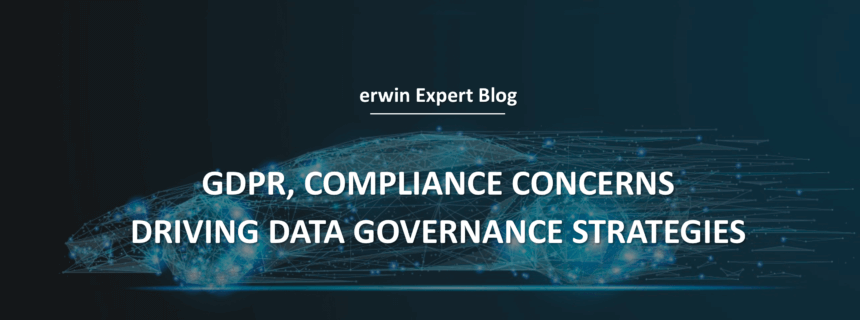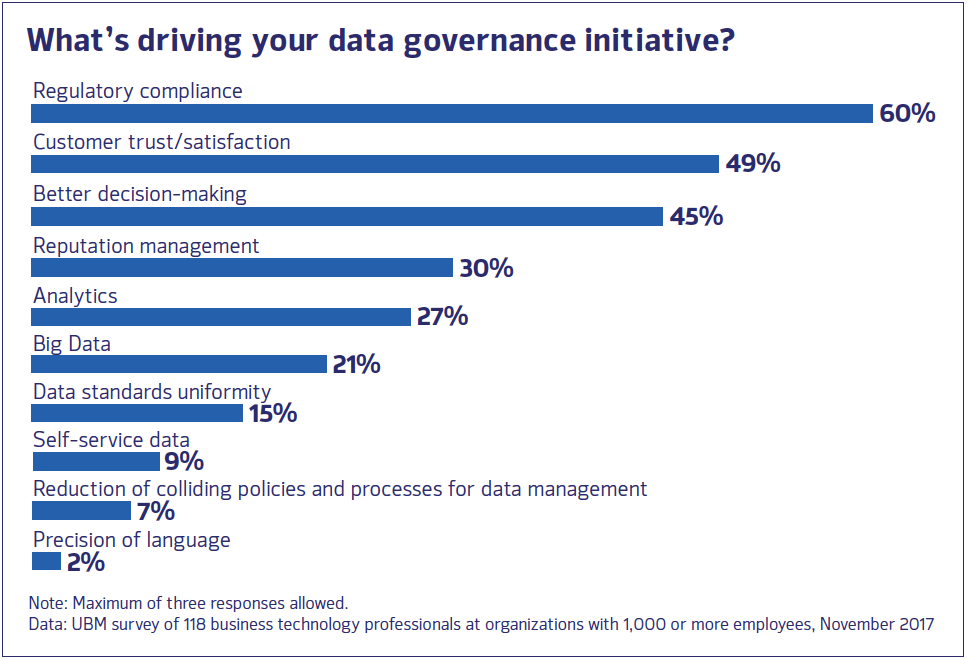GDPR, Compliance Concerns Driving Data Governance Strategies

There are many factors driving data governance adoption, as revealed in erwin’s State of Data Governance Report. Over the coming weeks, we’ll be exploring them in detail, starting with regulatory compliance.
By Michael Pastore
Almost every organization views data governance as important, so why don’t they all have it in place?
Modern organizations run on data. Whether from sensors monitoring equipment on a factory floor or a customer’s purchasing history, data enters modern businesses from every angle, gets stored in any number of places, and is used by many different people and applications.
Data governance refers to the practices that help businesses understand where their data comes from, where it resides, how accurate it is, who or what can access it, and how it can be used. The idea of data governance is not new, but putting data governance into practice and reaping the benefits remains a struggle for many organizations.
According to our November 2017 survey with UBM, nearly all (98 percent) respondents said their organizations view data governance as either important or critically important from a business perspective. Despite this, 46 percent of respondents indicated their organizations recognize the value of data, but lack a formal governance strategy.
One of the significant obstacles to data governance for many organizations is the idea of ownership. In many businesses, it’s safe to say that the IT organization has ownership over the network, just as it’s easy to say that the business oversees payroll.
Data is a bit more complicated. The business side of the organization often analyzes the data, but it’s the IT organization that stores and protects it. This data division of labor often leaves data governance in a sort of no-man’s land, with each side expecting the other to pick up the torch.
The results of the erwin-UBM survey indicate that businesses are increasingly treating data governance as an enterprise-wide imperative. At 57 percent of respondents’ organizations, both IT and the business are responsible for data governance. Just 34 percent of the organizations put IT solely in charge.
Strong data governance initiatives will overcome the issue of ownership thanks in part to a new organizational structure that considers the importance of data. The emergence of the chief data officer (CDO) is one sign that businesses recognize the vital role of their data.
Many of the first generation of CDOs reported to the CIO. Now, you’re more likely to see the CDO at forward-thinking organizations sit on the business side, perhaps in the finance department, or even marketing, which is a huge consumer of data in many businesses. Under the CDO, it’s increasingly likely to find a data protection officer (DPO) tasked with overseeing how the business safeguards its information.

Driving Data Governance: Compliance Is Leading Organizations to Data Governance
Now is a good time for businesses to re-think their data structure and governance initiatives. Data is central to organizations’ compliance, privacy and security initiatives because it has value — value to the business; value to the customer; and, like anything of value, value to criminals who want to get their hands on it.
The need to protect data and reduce risk is an important factor in driving data governance at many organizations. In fact, our survey found that regulatory compliance, cited by 60 percent of respondents, was the most popular factor driving data governance.
There’s an increased sense of urgency regarding data governance and compliance because of the European Union’s General Data Protection Regulation (GDPR), which goes into effect this month. According to our research, only 6 percent of respondents said their organization was “completely prepared” for the regulation.
Not only does the GDPR protect EU citizens at home, but it extends protections to EU citizens wherever they do business. It really goes much farther than any other legislation ever has.
The GDPR essentially gives rights to the people the data represents, so businesses must:
- Minimize identifiability in data
- Report data breaches within 72 hours
- Give consumers the ability to dispute data and demand data portability
- Understand the GDPR’s expanded definition of personally identifiable information (PII)
- Extend to consumers the right to be “forgotten”
And much, much more.
The maximum fine for organizations in breach of the GDPR is up to 4 percent of annual global turnover or €20 million, whichever is greater. And because the GDPR will apply to anyone doing business with EU citizens, and the internet transcends international borders, it’s likely the GDPR will become the standard organizations around the world will need to rise to meet.
The GDPR is a hot topic right now, but it’s not the only data-security regulation organizations have to honor. In addition to Payment Card Industry (PCI) standards for payment processors, industry-specific regulations exist in such areas as financial services, healthcare and education.
This web of regulations brings us back to data governance. Simply put, it’s easier to protect data and mitigate a breach if your organization knows where the data comes from, where it is stored, and what it includes.
Businesses stand to gain a number of advantages by implementing strong data governance. Regulatory compliance is sure to get the attention of C-level executives, the legal team and the board, but it means very little to consumers – until there’s a breach.
With new breaches being reported on a seemingly daily basis, businesses that practice strong data governance can help build a competitive advantage by better protecting their data and gaining a reputation as an organization that can be trusted in a way that firms suffering from high-profile breaches cannot. In this way, data governance helps contribute directly to the bottom line.
Still, compliance is the No. 1 factor driving data governance initiatives for a reason.
Using data governance to drive upside growth is great, but not if you’re going to lose money in fines.
In our next post in this series, we’ll explore how your organization can use data governance to build trust with your customers.
Michael Pastore is the Director, Content Services at QuinStreet B2B Tech. This content originally appeared as a sponsored post on http://www.eweek.com/.
Learn more about how data governance can help with GDPR compliance by downloading the free white paper: GDPR and Your Business: A Call to Enhance Data Governance Expertise.

